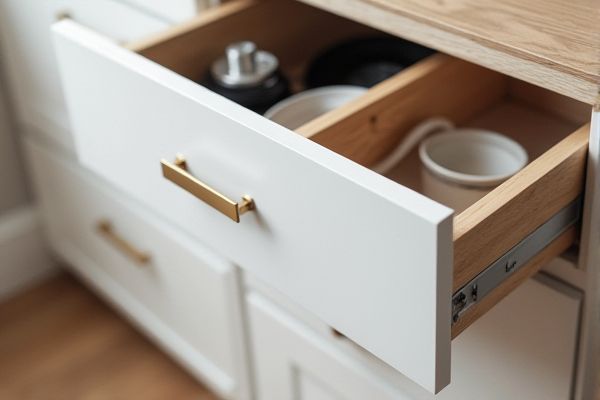
Soft-close drawers prevent slamming by using a damping mechanism, extending the lifespan of your cabinetry and reducing noise. Discover the key differences and benefits of soft-close versus regular drawers to make an informed choice for your home.
Table of Comparison
| Feature | Soft-Close Drawers | Regular Drawers |
|---|---|---|
| Closing Mechanism | Hydraulic or pneumatic dampers | Manual closing, no damping |
| Noise Level | Quiet, minimal noise | Often noisy, slamming sound |
| Durability | Enhanced drawer lifespan | Prone to wear from impacts |
| Cost | Higher initial cost | Lower upfront cost |
| User Experience | Smooth, gentle closure | Fast but harsh closure |
| Installation | Requires specific hardware | Standard drawer slides |
Introduction to Drawer Mechanisms
Soft-close drawers feature hydraulic or pneumatic mechanisms that gently slow the closing motion, preventing slamming and reducing wear compared to regular drawers with basic sliding hardware. These advanced drawer systems enhance longevity and provide a quieter, smoother user experience, ideal for high-traffic kitchens or offices. Your choice impacts durability and functionality, with soft-close options offering superior control and protection against damage.
What Are Soft-Close Drawers?
Soft-close drawers are equipped with advanced hydraulic or pneumatic mechanisms that gently slow the drawer's closing motion, preventing slamming and reducing noise. These innovative features improve the longevity of your cabinets by minimizing wear and tear on both the drawer and its frame. Choosing soft-close drawers enhances the overall user experience by offering smooth, quiet operation and added safety, especially in busy kitchens or homes with children.
What Are Regular Drawers?
Regular drawers operate with a simple mechanism where the drawer slides in and out without any built-in damping or cushioning, resulting in a straightforward and often louder closing motion. These drawers rely on manual force to close, which can cause noise, wear, and potential damage over time. Understanding the basic function of regular drawers is essential when considering the benefits of upgrading to soft-close alternatives for your cabinetry.
Installation and Compatibility
Soft-close drawers often require specific hardware and mounting systems compatible with their dampening mechanisms, making installation more precise compared to regular drawers. You may need to ensure your cabinet dimensions and existing drawer slides support soft-close features, which can involve replacing or upgrading parts for proper fit and function. Regular drawers generally offer straightforward installation with standard slides, providing broad compatibility across various cabinet designs without additional adjustments.
Durability and Maintenance
Soft-close drawers feature advanced dampening mechanisms that reduce wear and tear by preventing slamming, significantly increasing their durability compared to regular drawers. Their components require minimal maintenance, often needing only occasional lubrication to ensure smooth operation. In contrast, regular drawers experience more impact damage over time and may require more frequent repairs or adjustments due to their simpler sliding systems.
User Experience and Convenience
Soft-close drawers enhance user experience by preventing slamming noises and reducing wear on hardware, offering a quieter and more durable solution compared to regular drawers. The gentle and controlled closing mechanism increases convenience by eliminating the need for manual slowing, providing smooth and effortless operation. Your kitchen or furniture benefits from improved safety and longevity, making soft-close drawers a practical upgrade for everyday use.
Noise and Safety Considerations
Soft-close drawers significantly reduce noise by gently slowing down before closing, preventing the loud banging often associated with regular drawers. This feature enhances safety by minimizing the risk of fingers getting caught or pinched, making it especially beneficial in homes with children. Your environment becomes quieter and safer, improving overall comfort and usability.
Cost Comparison
Soft-close drawers generally have a higher upfront cost than regular drawers due to their specialized hardware and damping mechanisms. While regular drawers offer a more budget-friendly option with basic gliding features, soft-close models provide enhanced durability and user experience that can reduce maintenance expenses over time. Investment in soft-close drawers often results in long-term savings by preventing drawer damage and minimizing noise, justifying the initial price difference for many homeowners.
Best Applications for Each Type
Soft-close drawers are ideal for kitchens and bathrooms where quiet operation and preventing drawer slamming enhance safety and longevity. Regular drawers suit scenarios where budget constraints or traditional design aesthetics take precedence, such as in workshops or storage areas with less frequent access. Your choice depends on balancing noise reduction benefits with cost considerations and usage intensity.
Soft-Close vs Regular Drawers: Which Should You Choose?
Soft-close drawers feature a hydraulic mechanism that slows the drawer as it closes, preventing slamming and reducing noise, while regular drawers lack this technology and close abruptly. This innovation enhances durability by minimizing wear and tear on both drawer and cabinet components, making soft-close options ideal for high-use areas like kitchens and offices. Choosing between soft-close and regular drawers depends on your budget, desired noise reduction, and preference for a modern, gentle closing action.
 homyna.com
homyna.com